
John Ronald Philip[1] Reuel Tolkien (called Ronald for short; b. January 3, 1892 in South Africa – died September 2, 1973 in England) is best known as the author of The Hobbit and its sequel The Lord of the Rings. Among many academic positions, he was professor of Anglo-Saxon language at the University of Oxford from 1925 to 1945, and of English studies (English language and literature), also at Oxford, from 1945 to 1959. He was a strongly committed Roman Catholic. Tolkien was a close friend of C.S. Lewis, with whom he shared membership in the literary discussion group The Inklings.
In addition to The Hobbit, The Lord of the Rings, and a collection of poems, within his lifetime, Tolkien's published fiction includes The Silmarillion and other posthumously published books about what he called a legendarium, a fictional mythology of the remote past of Earth, called Arda, and Middle-earth (from middangeard, the lands inhabitable by Men) in particular. Most of these works were compiled from Tolkien's notes by his son Christopher Tolkien. The enduring popularity and influence of Tolkien's works have established him as the "father of the modern fantasy genre". Tolkien's other published fiction includes stories for children, not connected to his legendarium.
The significance of his literary oeuvre has generated decades of "Tolkien scholarship" and research across the Western world, and a considerable resulting output of secondary literature by many scholars and enthusiasts.
The Tolkien family
As far as is known, most of Tolkien's paternal ancestors were craftsmen. The Tolkien family had its roots in Saxony (Germany) but had been living in England since the eighteenth century, becoming "quickly and intensely English (not British)".[2] The surname Tolkien is anglicized from Tollkiehn (i.e. German tollkühn, "foolhardy", literally "insane(ly)-brave", the etymological English translation would be dull-keen, a literal translation of oxymoron). The surname Rashbold of two characters in The Notion Club Papers is a pun on this.[3]
Biography
Childhood
Tolkien was born on January 3, 1892, in Bloemfontein in the Orange Free State (now South Africa) to Arthur Tolkien, an English bank manager, and his wife Mabel, née Suffield (1870–1904). Tolkien had one sibling, his younger brother, Hilary Arthur Reuel, who was born on February 17, 1894.[4]
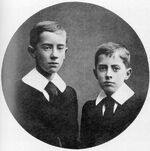
While living in Africa, he was bitten by a large tarantula in the garden, an event which would have later parallels in his stories.[5] When he was three, Tolkien went to England with his mother and brother on what was intended to be a lengthy family visit. His father, however, died in South Africa of rheumatic fever before he could join them.[6] This left the family without an income, so Tolkien's mother took him to live with her parents in Birmingham, England. Soon after in 1896, they moved to Sarehole (now in Hall Green), then a Worcestershire village, later annexed to Birmingham.[7] He enjoyed exploring Sarehole Mill, Moseley Bog, the Clent Hills, and Lickey Hills, which would later inspire scenes in his books along with other Worcestershire towns and villages such as Bromsgrove, Alcester and Alvechurch and places such as his aunt's farm of Bag End, the name of which would be used in his fiction.[8]
Mabel tutored her two sons, and Ronald, as he was known in the family, was a keen pupil.[9] She taught him a great deal of botany, and she awoke in her son the enjoyment of the look and feel of plants. Young Tolkien liked to draw landscapes and trees. But his favourite lessons were those concerning languages, and his mother taught him the rudiments of Latin very early.[10] He could read by the age of four and could write fluently soon afterward. He attended King Edward's School, Birmingham, and, while a student there, helped "line the route" for the coronation parade of King George V, being posted just outside the gates of Buckingham Palace.[11] He later attended St. Philip's School and Exter College, Oxford.
His mother converted to Roman Catholicism in 1900 despite vehement protests by her Baptist family.[12] She died of diabetes in 1904, when Tolkien was twelve, at Fern Cottage, Rednal, which they were then renting. For the rest of his life, Tolkien felt that she had become a martyr for her faith; this had a profound effect on his own Catholic beliefs.[13] Tolkien's devout faith was significant in the conversion of C.S. Lewis to Christianity, though Tolkien was greatly disappointed that Lewis chose to follow Anglicanism.[14]
During his subsequent orphanhood, he was brought up by Father Francis Xavier Morgan of the Birmingham Oratory in the Edgbaston area of Birmingham. He lived there in the shadow of Perrot's Folly and the Victorian tower of Edgbaston waterworks, which may have influenced the images of the dark towers within his works. Another strong influence was the romantic medievalist paintings of Edward Burne-Jones and the Pre-Raphaelite Brotherhood; the Birmingham Museum and Art Gallery has a large and world-renowned collection of works and had put it on free public display from around 1908.
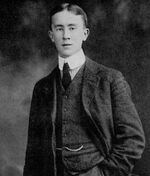
Youth
Tolkien met and fell in love with Edith Mary Bratt, three years his senior, at the age of sixteen. Father Francis forbade him from meeting, talking, or even corresponding with her until he was twenty-one. He obeyed this prohibition to the letter.[15]
In 1911 at age 19, while they were at King Edward's School, Birmingham, Tolkien, and three friends, Robert Quilter Gilson, Geoffrey Bache Smith, and Christopher Wiseman, formed a semi-secret society which they called the Tea Club, Barrovian Society, with the acronym, "T.C.B.S.", alluding to their fondness of drinking tea in Barrow's Stores near the school and, illicitly, in the school library.[16] After leaving school, the members stayed in touch, and in December 1914, they held a "Council" in London, at Wiseman's home. For Tolkien, the result of this meeting was a strong dedication to writing poetry.
In the summer of 1911, Tolkien went on holiday in Switzerland, a trip that he recollects vividly in a 1968 letter,[11] noting that Bilbo's journey across the Misty Mountains ("including the glissade down the slithering stones into the pine woods") is directly based on his adventures as their party of twelve hiked from Interlaken to Lauterbrunnen, and on to camp in the moraines beyond Mürren. Fifty-seven years later, Tolkien remembers his regret at leaving the view of the eternal snows of Jungfrau and Siilberhorn ("the Silvertine (Celebdil) of my dreams"). They went across the Kleine Scheidegg on to Grindelwald and across the Grosse Scheidegg to Meiringen. They continued across the Grimsel Pass and through the upper Valais to Brig, and on to the Aletsch glacier and Zermatt.
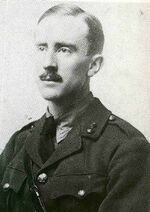
Young adulthood
On the evening of his twenty-first birthday, literally at midnight, Tolkien wrote to Edith a declaration of his love and asked her to marry him. She replied saying that she was already engaged but had done so because she had believed Tolkien had forgotten her. The two met up and beneath a railway viaduct renewed their love; Edith returned her ring and chose to marry Tolkien instead.[17] Following their engagement Edith converted to Catholicism at Tolkien's insistence.[18] They were engaged in Birmingham, in January 1913, and married in Warwick, England, on March 22, 1916.[19]
With his childhood love of landscape, he visited Cornwall in 1914 and he was said to be deeply impressed by the singular Cornish coastline and sea.[20] After graduating from the University of Oxford (Exeter College, Oxford) with a first-class degree in the English language in 1915, Tolkien joined the British Army effort in World War I and served as a second lieutenant in the eleventh battalion of the Lancashire Fusiliers.[21] His battalion was moved to France in 1916, where Tolkien served as a communications officer during the Battle of the Somme until he came down with trench fever on October 27 and was moved back to England on November 8.[22] Many of his fellow servicemen, as well as many of his closest friends, were killed in the war. During his recovery at Gypsy Green Cottage in Great Haywood, Staffordshire, England, he began to work on what he called The Book of Lost Tales, beginning with The Fall of Gondolin (which was not finished or published in his lifetime). Throughout 1917 and 1918 his illness kept recurring, but he had recovered enough to do home service at various camps and was promoted to lieutenant. When he was stationed at Kingston upon Hull, one day he and Edith went walking in the woods at nearby Roos, and Edith began to dance for him in a thick grove of hemlock; "We walked in a wood where hemlock was growing, a sea of white flowers". This incident inspired the account of the meeting of Beren and Lúthien, and Tolkien often referred to Edith as his Lúthien.[23]
Tenure
Tolkien's first civilian job after World War I was at the Oxford English Dictionary,[24] as an editor's assistant.[25] In 1920 he took up a post as Reader in the English language at the University of Leeds, and in 1924 was made a professor there, but in 1925 he returned to Oxford as a professor of Anglo-Saxon at Pembroke College.[26]
Tolkien and Edith had four children: John Francis Reuel (November 17, 1917 - January 22, 2003), Michael Hilary Reuel (October 1920–1984), Christopher John Reuel (November 21, 1924 - January 16, 2020), and Priscilla Anne Reuel (June 18, 1929 - February 28, 2022). Tolkien assisted Sir Mortimer Wheeler in the unearthing of a Roman Asclepieion at Lydney Park, Gloucestershire, in 1928.[27] During his time at Pembroke, Tolkien wrote The Hobbit and the first two volumes of The Lord of the Rings. Of Tolkien's academic publications, the 1936 lecture Beowulf: The Monsters and the Critics had a lasting influence on Beowulf research.[28] Lewis E. Nicholson noted that the article Tolkien wrote about Beowulf is "widely recognized as a turning point in Beowulfian criticism", noting that Tolkien established the primacy of the poetic nature of the work as opposed to the purely linguistic elements.[29] He also revealed in his famous article how highly he regarded Beowulf; "Beowulf is among my most valued sources ..." And indeed, there are many influences of Beowulf found in The Lord of the Rings.[30] [[File:IMG 1305.JPG|left|thumb|220x220px|Tolkien's desk on which he drafted The Hobbit, on display at the Marion E. Wade Center at [[wikipedia:Wheaton_College_(Illinois) Wheaton College], Illinois]] [[File:TolkienWithWife.jpg|thumb|331x331px|Tolkien and his wife Edith in Bournemouth]] In 1945, he moved to Merton College, Oxford, becoming the Merton Professor of English Language and Literature, in which post he remained until his retirement in 1959. Tolkien completed The Lord of the Rings in 1948, close to a decade after the first sketches. During the 1950s, Tolkien spent many of his long academic holidays at the home of his son John Francis in Stoke-on-Trent. Tolkien had an intense dislike for the side effects of industrialisation which he considered a devouring of the English countryside. For most of his adult life, he eschewed automobiles, preferring to ride a bicycle.[31] This attitude is perceptible from some parts of his work such as the forced industrialisation of the Shire in The Lord of the Rings.
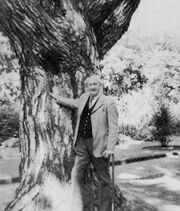
W.H. Auden was a frequent correspondent and long-time friend of Tolkien's, initiated by Auden's fascination with The Lord of the Rings: Auden was among the most prominent early critics to praise the work. Tolkien wrote in a 1971 letter, "I am [...] very deeply in Auden's debt in recent years. His support of me and interest in my work has been one of my chief encouragements. He gave me very good reviews, notices, and letters from the beginning when it was by no means a popular thing to do. He was, in fact, sneered at for it.".[32]
Retirement and old age
During his life in retirement, from 1959 up to his death in 1973, Tolkien increasingly turned into a figure of public attention and literary fame. The sale of his books was so profitable that Tolkien regretted he had not taken early retirement.[33] While at first, he wrote enthusiastic answers to reader inquiries, he became more and more suspicious of emerging Tolkien fandom, especially among the hippy movement in the USA.[34] In a 1972 letter, he deplores having become a cult-figure, but admits that
- even the nose of a very modest idol (younger than Chu-Bu and not much older than Sheemish) cannot remain entirely untickled by the sweet smell of incense!.[35]
Fan attention became so intense that Tolkien had to take his phone number out of the public directory,[36] and eventually he and Edith moved to Bournemouth at the south coast. Tolkien was awarded a CBE by Queen Elizabeth II at Buckingham Palace on March 28, 1972.
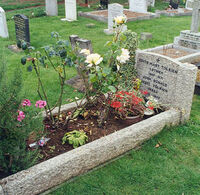
Edith Tolkien died on November 29, 1971, at the age of eighty-two, and Tolkien had the name Lúthien engraved on the stone at Wolvercote Cemetery, Oxford. When Tolkien died 21 months later on September 2, 1973, at the age of 81, he was buried in the same grave, with Beren added to his name, so that the engraving now reads: Edith Mary Tolkien, Lúthien, 1889 - 1971 John Ronald Reuel Tolkien, Beren, 1892–1973
Posthumously named after Tolkien are the Tolkien Road in Eastbourne, East Sussex, and the asteroid 2675 Tolkien. Tolkien Way in Stoke-on-Trent is named after Tolkien's son Father John Francis Tolkien, who was the priest in charge at the nearby Roman Catholic Church of Our Lady of the Angels and St. Peter in Chains.[37]
Writing
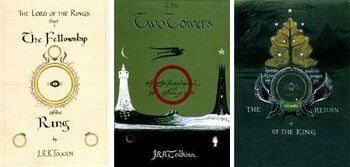
Beginning with The Book of Lost Tales, written while recuperating from illness during World War I, Tolkien devised several themes that would be reused in initial successive drafts of his legendarium. The two most prominent stories, the tales of Beren and Lúthien and that of Túrin Turambar in the First Age, were carried forward into long narrative poems (published in The Lays of Beleriand). Tolkien wrote a brief summary of the mythology these poems were intended to represent, and that summary eventually evolved into The Silmarillion, an epic history that Tolkien started three times but never published. It was originally to be published along with The Lord of the Rings, but printing costs were very high in the post-war years, later leading to The Lord of the Rings being published in three books.[38] The story of this continuous redrafting is told in the posthumous series The History of Middle-earth. From around 1936, he began to extend this framework to include the tale of the Fall of Númenor, which was inspired by the legend of Atlantis.
Tolkien was strongly influenced by Anglo-Saxon literature, Germanic and Norse mythologies, Finnish mythology, the Bible, and Greek mythology.[39] The works most often cited as sources for Tolkien's stories include Beowulf, the Kalevala, the Poetic Edda, the Volsunga saga and the Hervarar saga.[40] Tolkien himself acknowledged Homer, Oedipus, and the Kalevala as influences or sources for some of his stories and ideas.[41] His borrowings also came from numerous Middle English works and poems. A major philosophical influence on his writing is King Alfred's Anglo-Saxon version of Boethius' Consolation of Philosophy known as the Lays of Boethius.[42] Characters in The Lord of the Rings such as Frodo, Treebeard, and Elrond make noticeably Boethian remarks.
In addition to his mythological compositions, Tolkien enjoyed inventing fantasy stories to entertain his children.[43] He wrote annual Christmas letters from Father Christmas for them, building up a series of short stories (later compiled and published as Letters From Father Christmas). Other stories included Mr. Bliss, Roverandom, Smith of Wootton Major, Farmer Giles of Ham, and Leaf by Niggle. Roverandom and Smith of Wootton Major, like The Hobbit, borrowed ideas from his legendarium. Leaf by Niggle appears to be an autobiographical work, where a "very small man", Niggle, keeps painting leaves until finally, he ends up with a tree.[44]
Tolkien never expected his fictional stories to become popular, but he was persuaded by C.S. Lewis to publish a book he had written for his own children called The Hobbit in 1937.[45] However, the book attracted adult readers as well, and it became popular enough for the publisher, Allen & Unwin, to ask Tolkien to work on a sequel.
Even though he felt uninspired on the topic, this request prompted Tolkien to begin what would become his most famous work: the epic three-volume novel The Lord of the Rings (published 1954–55). Tolkien spent more than ten years writing the primary narrative and appendices for The Lord of the Rings, during which time he received the constant support of The Inklings, in particular his closest friend C.S. Lewis, the author of The Chronicles of Narnia. Both The Hobbit and The Lord of the Rings are set against the background of The Silmarillion, but in a time long after it.

Tolkien at first intended The Lord of the Rings as a children's tale like The Hobbit, but it quickly grew darker and more serious in the writing.[46] Though a direct sequel to The Hobbit, it addressed an older audience, drawing on the immense back story of Beleriand that Tolkien had constructed in previous years, and which eventually saw posthumous publication in The Silmarillion and other volumes. Tolkien's influence weighs heavily on the fantasy genre that grew up after the success of The Lord of the Rings.
Tolkien continued to work on the history of Middle-earth until his death. His son Christopher, with some assistance from fantasy writer Guy Gavriel Kay, organized some of this material into one volume, published as The Silmarillion in 1977. In 1980 Christopher Tolkien followed this with a collection of more fragmentary material under the title Unfinished Tales of Númenor and Middle-earth, and in subsequent years he published a massive amount of background material on the creation of Middle-earth in the twelve volumes of The History of Middle-earth. All these posthumous works contain unfinished, abandoned, alternative and outright contradictory accounts, since they were always a work in progress, and Tolkien only rarely settled on a definitive version for any of the stories. There is not even complete consistency to be found between The Lord of the Rings and The Hobbit, the two most closely related works because Tolkien was never able to fully integrate all their traditions into each other. He commented in 1965 while editing The Hobbit for a third edition, that he would have preferred to completely rewrite the entire book.[47]
The Lord of the Rings became immensely popular in the 1960s and has remained so ever since, ranking as one of the most popular works of fiction of the twentieth century, judged by both sales and reader surveys.[48] In the 2003 "Big Read" survey conducted by the BBC, The Lord of the Rings was found to be the "Nation's Best-loved Book". Australians voted The Lord of the Rings "My Favourite Book" in a 2004 survey conducted by the Australian ABC.[49] In a 1999 poll of Amazon.com customers, The Lord of the Rings was judged to be their favourite "book of the millennium".[50] In 2002 Tolkien was voted the ninety-second "greatest Briton" in a poll conducted by the BBC, and in 2004 he was voted thirty-fifth in the SABC3's Great South Africans, the only person to appear in both lists. His popularity is not limited just to the English-speaking world: in a 2004 poll inspired by the UK’s "Big Read" survey, about 250,000 Germans found The Lord of the Rings (Der Herr der Ringe) to be their favourite work of literature.[51]
Humphrey Carpenter chronicled all of Tolkien's published poems and writings in "Appendix C" of his authorized biography, J.R.R. Tolkien: A Biography (1977).
Six of Tolkien's major academic lectures, such as his important 1936 lecture on Beowulf, and one essay were compiled into The Monsters and the Critics and other essays in 1983 by Christopher Tolkien.
Manuscripts
Early drafts of The Lord of the Rings (initially titled "The Magic Ring") were sold to Marquette University in Milwaukee, Wisconsin, in 1956 for £1,500 pounds sterling (about $4,700). Over 11,000 pages were included, text and a few illustrations.[52] Other original material survives at Oxford's Bodleian Library. Marquette has the manuscripts and proofs of The Hobbit, and other manuscripts including Farmer Giles of Ham, while the Bodleian holds The Silmarillion papers and Tolkien's academic work.[53]
As of the 2000's, many of his manuscripts have been featured in the publications Tolkien: Maker of Middle-earth (2018) and The Art of The Lord of the Rings by J.R.R. Tolkien (2015).
Languages
- See also: Languages of Middle-earth
Both Tolkien's academic career and his literary production are inseparable from his love of language and philology. He specialized in Greek philology in college, and in 1915 graduated with Old Icelandic as a special subject. He contributed to the Oxford English Dictionary in 1918. Two years later he went to Leeds, where he claimed credit for raising the number of students of linguistics from five to twenty. He gave courses in Old English heroic verse, history of English, various Old English and Middle English texts, Old and Middle English philology, introductory Germanic philology, Gothic, Old Icelandic, and Medieval Welsh. When in 1925, aged 33, Tolkien applied for the Rawlinson and Bosworth Professorship of Anglo-Saxon, he boasted that his students of Germanic philology in Leeds had even formed a "Viking Club".[54]
Privately, Tolkien was attracted to "things of racial and linguistic significance", and he entertained notions of an inherited taste of language, which he termed the "native tongue" as opposed to "cradle tongue" in his 1955 lecture English and Welsh, which is crucial to his understanding of race and language. He considered West-Midland Middle English his own "native tongue", and, as he wrote to W. H. Auden in 1955,[55] "I am a West-Midlander by blood (and took to early West-Midland Middle English as a known tongue as soon as I set eyes on it)"
Parallel to Tolkien's professional work as a philologist, and sometimes overshadowing this work, to the effect that his academic output remained rather thin, was his affection for the construction of artificial languages. The best developed of these are Quenya and Sindarin, the etymological connection between which are at the core of much of Tolkien's legendarium. Language and grammar for Tolkien were a matter of aesthetics and euphony, and Quenya in particular were designed from "phonaesthetic" considerations; it was intended as an "Elvenlatin": phonologically based on Latin with ingredients from Finnish and Greek.[56] A notable addition came in late 1945 with Adûnaic, a language of a "faintly Semitic flavour", connected with Tolkien's Atlantis myth, which by The Notion Club Papers ties directly into his ideas about the inheritability of language, and via the "Second Age" and the Eärendil myth was grounded in the legendarium, thereby providing a link of Tolkien's twentieth-century "real primary world" with the mythical past of his Middle-earth.
Names and pseudonyms
Arthur Tolkien once wrote a letter which contains some inspiration behind J.R.R. Tolkien's name:
"The boy’s first name will be ‘John’ after its grandfather, probably John Ronald Reuel altogether. Mab wants to call it Ronald and I want to keep up John and Reuel." Ronald had no familial precedent but Reuel was Arthur's middle name.[57]
- Luttro - An Esperanto word meaning "otter", which may refer to Tolkien himself in his private Book of the Foxrook since Otter is his name in Animalic.[58]
- Arcastar - A Quenya name meaning "translator" or "one who carries across",[59] which Tolkien used once to sign his name.[60][61]
- Eisphorides Acribus Polyglotteus, orator Graecorum - Tag name in the annual Latin debates during studies at Oxford.[62]
- Fisiologus - pen name Tolkien used for the poem, Adventures in Unnatural History and Medieval Metres, being the Freaks of Fisiologus, that was published in the Stapeldon Magazine in June of 1927.
- J. - Tolkien's signature for a poem that was published in the Stapeldon Magazine in 1913.
- John - [63]
- JRsquared - [63]
- Kingston Bagpuize- Pen name used for the poem, Progress in Bimble Town, that was published in the Oxford Magazine on October 15 in 1931.
- Rægnold Hrædmóding - An Old English translation of Tolkien which he used as his signature for the poem, For W.H.A., in 1967.
- Ronald - The name which was used by Tolkien's near kin.[63]
- Ruginwaldus Dwalakôneis - A "Gothicizied" translation of Tolkien's name.[64]
- Tollers - A name used by the Inklings and other intimate friends for Tolkien.[65][66]
- N.N. - A pen name used for the poem, The Clerkes Compleinte, that was published in The Gryphon in 1922; it is an abbreviation of Nomen Nescio.
- Oxymore - A pen name of the 1927 poem Knocking at the Door: Lines Induced by Sensations When Waiting for an Answer at the Door of an Exalted Academic Person, that was published in the Oxford Magazine on February 18 in 1937.
Portrayal in film
A 24-year old J.R.R. Tolkien is portrayed in the 2019 biographical film Tolkien by English actor Nicholas Hoult, marking the first time Tolkien has been represented by an actor on-screen.
Media
Videos
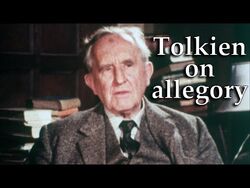



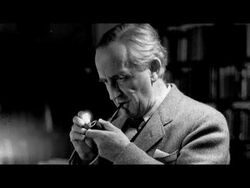
References
- ↑ What’s in a Name? Tolkien and St. Philip Neri, an article by Dr. Holly Ordway, May 26, 2023
- ↑ The Letters of J. R. R. Tolkien, Letter 165
- ↑ (undergraduate John Jethro Rashbold, and "old Professor Rashbold at Pembroke"; Sauron Defeated, pg 151, Letters, 165)
- ↑ (Biography 1977, pg 22)
- ↑ (Biography 1977, pg 21)
- ↑ (Biography 1977, pg 24)
- ↑ (Biography 1977, pg 27)
- ↑ (Biography 1977, pg 113)
- ↑ (Biography 1977, pg 29)
- ↑ Doughan, David (2002). JRR Tolkien Biography. Life of Tolkien. Retrieved on 2006-03-12.
- ↑ 11.0 11.1 (Letters, no. 306)
- ↑ (Biography 1977, pg 31)
- ↑ (Biography 1977, pg 39)
- ↑ Carpenter, Humphrey (1978). The Inklings. Allen & Unwin.
- ↑ Doughan, David (2002). War, Lost Tales And Academia. J. R. R. Tolkien: A Biographical Sketch. Retrieved on 2006-03-12.
- ↑ (Biography 1977, pg 53-54)
- ↑ (Biography 1977, pg 67-69)
- ↑ (Biography 1977, pg 73)
- ↑ (Biography 1977, pg 86)
- ↑ (Biography 1977, pg 78)
- ↑ (Biography 1977, pg 85)
- ↑ (Biography 1977, pg 93)
- ↑ Cater, Bill (April 12, 2001). We talked of love, death, and fairy tales=HTML. UK Telegraph. Retrieved on 2006-03-13.
- ↑ among others, initiating the entries wasp and walrus; Tritel, Barbara (May 27, 1984). Language and Prehistory of the Elves. New York Times. Retrieved on 2006-03-12.
- ↑ Peter Gilliver, Jeremy Marshall, Edmund Weiner, The Ring of Words
- ↑ (Biography 1977, pg 109, 114-115)
- ↑ See The Name Nodens (1932)
- ↑ (Biography 1977, pg 143)
- ↑ Ramey, Bill (March 30, 1998). The Unity of Beowulf: Tolkien and the Critics. Wisdom's Children. Retrieved on 2006-03-13.
- ↑ Kennedy, Michael (2001). Tolkien and Beowulf- Warriors of Middle-earth. Amon Hen. Retrieved on 2006-03-13.
- ↑ (Letters no. 64, 131, etc.)
- ↑ (Letters, no. 327)
- ↑ Doughan, David (2002). JRR Tolkien Biography. Life of Tolkien. Retrieved on 2006-03-13.
- ↑ Meras, Phyllis (January 15, 1967). Go, Go, Gandalf. New York Times. Retrieved on 2006-03-12.
- ↑ (Letters, no. 336; Chu-Bu and Sheemish are idols in a 1912 story by Lord Dunsany)
- ↑ (Letters, no. 332)
- ↑ People of Stoke-on-Trent. Retrieved on 2005-03-13.
- ↑ Hammond, Wayne G. J.R.R. Tolkien: A Descriptive Biography, London: January 1993, Saint Pauls Biographies
- ↑ (February 1, 2002) Tolkien's Ring. New York: Barnes and Noble. ISBN 1-586-63527-1.
- ↑ As described by Christopher Tolkien in Hervarar Saga ok Heidreks Konung (Oxford University, Trinity College). B. Litt. thesis. 1953/4. [Year uncertain], The Battle of the Goths and the Huns, in: Saga-Book (University College, London, for the Viking Society for Northern Research) 14, part 3 (1955-6) [1]
- ↑ Handwerk, Brian (March 1, 2004). Lord of the Rings Inspired by an Ancient Epic. National Geographic News. Retrieved on 2006-03-13.
- ↑ Gardner, John (October 23, 1977). The World of Tolkien. New York Times. Retrieved on 2006-03-13.
- ↑ Phillip, Norman (2005). The Prevalance of Hobbits. New York Times. Retrieved on 2006-03-12.
- ↑ Site Editor (2005). Leaf by Niggle - a symbolic story about a small painter. Leaf by Niggle. Retrieved on 2006-03-12.
- ↑ Times Editorial Staff (September 3, 1973). J.R.R. Tolkien Dead at 81: Wrote "The Lord of the Rings". New York Times. Retrieved on 2006-03-12.
- ↑ Times Editorial Staff (June 5, 1955). Oxford Calling. New York Times. Retrieved on 2006-03-12.
- ↑ Martinez, Michael (December 7th, 2004). Middle-earth Revised, Again. Merp.com. Retrieved on 2006-03-13.
- ↑ Seiler, Andy (December 16, 2003). 'Rings' comes full circle. USA Today. Retrieved on 2006-03-12.
- ↑ Cooper, Callista (December 5, 2005). Epic trilogy tops favorite film poll. ABC News Online. Archived from the original on 2005-12-29. Retrieved on 2006-03-12.
- ↑ O'Hehir, Andrew (June 4, 2001). The book of the century. Salon.com. Retrieved on 2006-03-12.
- ↑ Diver, Krysia (October 5, 2004). A lord for Germany. The Sydney Morning Herald. Retrieved on 2006-03-12.
- ↑ Marquette University (2003-03-04). J.R.R. Tolkien Collection. Retrieved on 2007-04-16.
- ↑ McDowell, Edwin (September 4, 1983). Middle Earth Revisited. New York Times. Retrieved on 2006-03-12.
- ↑ (Letter dated 27 June 1925 to the Electors of the Rawlinson and Bosworth Professorship of Anglo-Saxon, University of Oxford, Letters, no. 7)
- ↑ The Letters of J.R.R. Tolkien, Letter 163
- ↑ (Letters, no. 144, 25 April 1954, to Naomi Mitchison)
- ↑ Humphrey Carpenter, J.R.R. Tolkien: A Biography, II. "1892-1916: Early years"
- ↑ Dimitra Fimi and Andrew Higgins, A Secret Vice: Tolkien on Invented Languages, pgs. 40-1 (note 19)
- ↑ Ryszard I. Derdziński, "Arcastar means 'Translator'?"
- ↑ Lambengolmor discussion of Tolkien in Oxford, "Anders Stenström (9.32)", "Carl F. Hostetter (9.33)", "Roman Rausch (9.34)"
- ↑ Valuable Print Books and Manuscripts
- ↑ John Garth, Tolkien and the Great War, Part One: "The immortal four", pg. 19
- ↑ 63.0 63.1 63.2 The Letters of J. R. R. Tolkien, Letter 309
- ↑ The Letters of J. R. R. Tolkien, Letter 272
- ↑ Christina Scull and Wayne G. Hammond, The J.R.R. Tolkien Companion and Guide, II: "Reader's Guide", pg. 626
- ↑ Humphrey Carpenter, J.R.R. Tolkien: A Biography, II. "1892-1916: Early years", pg. 13
